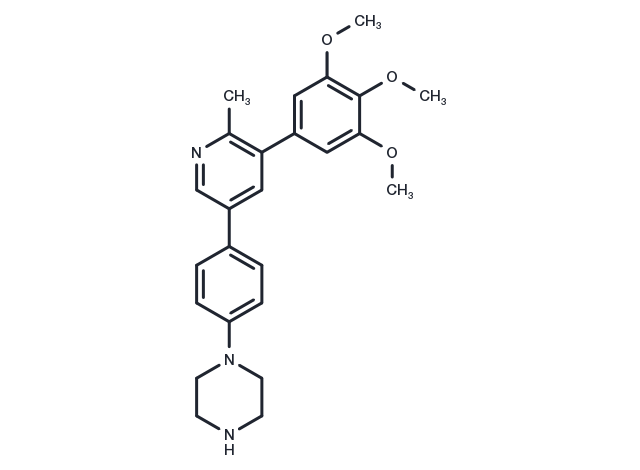Powder: -20°C for 3 years | In solvent: -80°C for 1 year


LDN-214117 is a potent and selective ALK2 inhibitor.

| Pack Size | Availability | Price/USD | Quantity |
|---|---|---|---|
| 2 mg | In stock | $ 33.00 | |
| 5 mg | In stock | $ 52.00 | |
| 10 mg | In stock | $ 93.00 | |
| 25 mg | In stock | $ 182.00 | |
| 50 mg | In stock | $ 312.00 | |
| 100 mg | In stock | $ 482.00 | |
| 1 mL * 10 mM (in DMSO) | In stock | $ 57.00 |




| Description | LDN-214117 is a potent and selective ALK2 inhibitor. |
| Targets&IC50 | ALK2:24 nM |
| In vivo | LDN-214117 exhibits selective inhibition towards BMP6 over BMP2 or BMP4. In cell-based assays, it preferentially inhibits BMP6 with an IC50 around 100 nM, being 164 times more selective for BMP6 than for TGF-β1. Among kinases, LDN-214117 most effectively inhibits ALK2 (IC50 = 24 nM), followed by TNIK, RIPK2, and ABL1. It specifically inhibits the kinase activity of ALK2 and ALK1 more than that of ALK3. |
| Kinase Assay | ALK2 kinase assay: Puri?ed recombinant ALK2 proteins, ATP, ATP[γ-32P], and dephosphorylated casein at ?nal concentrations of 2.5 nM, 6 μM, 0.05 μCi/μL , and 0.5 mg/mL, respectively, are aliquoted in kinase bu?er containing 0.2% BSA supplemented with 10 mM MnCl2 into 96-microwell plates, in combination with inhibitor compounds diluted at varying concentrations (0.01 nM to 100 μM). Positive control samples lacking inhibitor compounds, and negative controls lacking recombinant kinase, are also measured. The mixture is reacted at RT for 45 min, quenched with a ?nal concentration of 2% phosphoric acid. The reaction mixture is transferred to 96-well P81 phosphocellulose ?lter plates and bound for 5 min. The plates are washed 20 times with 150 μL of 1% phosphoric acid solution per well by vacuum manifold. Plates are dried at RT for 1 h, sealed, and assayed with Microscint 20 scintillation ?uid using a Spectramax L luminometer. Data is normalized to positive controls at 100% enzyme activity, with negative controls being subtracted as background. |
| Cell Research | Cells are seeded at 25000 cells per well in 96-well plates and incubated for 2 h at 37℃ and 5% CO2. Compounds of LDN-214117 or DMSO are diluted in DMEM and added at ?nal compound concentrations of 1, 10, and 100 μM. Cells are incubated for 4 and 24 h, after which the media is discarded. Cells are lysed by adding 30 μL of passive lysis bu?er and shaken at RT for 15 min. Cell viability is determined by quantifying the ATP present in each well by adding 10 μL of Cell Titer Glo per well and measuring the light output by Spectramax L luminometer. Data is normalized to 100% viability for cells receiving only DMSO.(Only for Reference) |
| Molecular Weight | 419.52 |
| Formula | C25H29N3O3 |
| CAS No. | 1627503-67-6 |
Powder: -20°C for 3 years | In solvent: -80°C for 1 year
Ethanol: 42 mg/mL (100 mM)
DMSO: 42 mg/mL (100 mM)
You can also refer to dose conversion for different animals. More
bottom
Please see Inhibitor Handling Instructions for more frequently ask questions. Topics include: how to prepare stock solutions, how to store products, and cautions on cell-based assays & animal experiments, etc.
LDN-214117 1627503-67-6 Angiogenesis Stem Cells Tyrosine Kinase/Adaptors ALK TGF-beta/Smad ALK2 BMP4 BMP2 Transforming growth factor beta receptors BMP6 TGF-β Receptor diffuse intrinsic pontine glioma(DIPG) oral ALK3 fibrodysplasia ossificans progressiva (FOP) ALK5 type I receptor kinases ALK1 LDN214117 bone morphogenetic proteins (BMPs) LDN 214117 inhibitor inhibit
